 |
In the Adventures of Buck Danny, starting from WW-II till today, several famous aircraft carriers are shown. The majority of them are US-Navy aircraft carriers, but in some adventures Japanese, French and Russian aircraft carriers are also represented.
In his flying career Buck Danny was stationed at 12 aircraft-cariers: (in chronological order) the USS Yorktown (CV-5), the USS Boxer (CV-21), the USS Falley Forge (CV-45), the USS Forrestal (CV-59),
the USS Saratoga (CV-60), the USS Enterprise (CV-65), the USS Ranger (CV-61), the USS John F. Kennedy (CV-67), the USS Theodore Roosevelt (CV-71), the USS Eisenhower (CV-69), the USS Harry
Truman (CV-75) and the USS Ronald Reagan (CV-76).
|
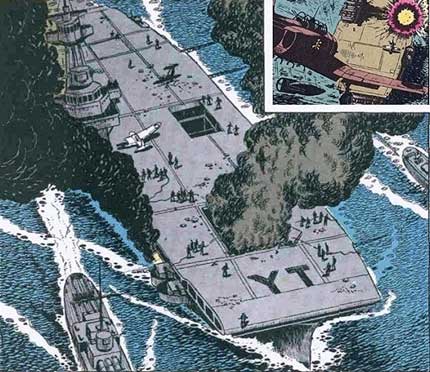
| The WWII US Navy aircraft carrier USS Yorktown is shown in the story LES JAPS ATTAQUENT and LES MYSTERES DE MIDWAY. |
The WWII US Navy aircraft carrier USS Yorktown is also well represented by Bergese in the short adventure LE LACHE published as inedit story on the Les aventures de Buck Danny rècit complet special volume ALERTE NUCLÈAIRE. |

|
The WWII US Navy aircraft carrier USS Yorktown under attack from Japanese aircrfats is represented by Marniquet in the short story L'INEVITABLE RENCONTRE published in 2017 as inedit story on the comic SPIROU #4108 dedicated to the 70th years of the Buck Danny adventures. |
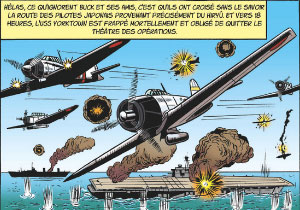
|
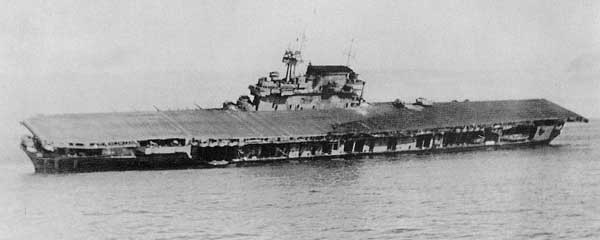 |
USS Yorktown (CV-5) was an aircraft carrier commissioned in the United States Navy from 1937 until she was sunk at the Battle of Midway in June 1942. She was named after the Battle of Yorktown in 1781 and the lead ship of the Yorktown class which was designed after lessons learned from operations with the large converted battlecruiser Lexington class and the smaller purpose-built USS Ranger (CV-4). She represented the epitome of U.S. pre-war carrier design. |
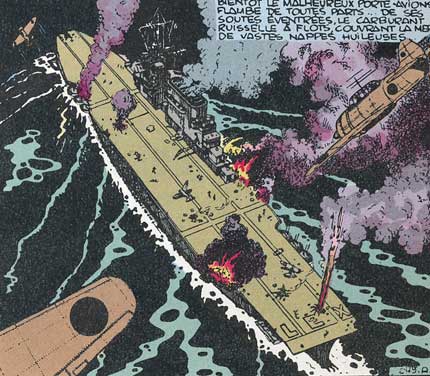 |
The US Navy WWII aircraft carrier USS Lexington is also shown in the story LES JAPS ATTAQUENT.
|
USS Lexington (CV-2), nicknamed "Lady Lex", was an early aircraft carrier built for the United States Navy. She was the lead ship of the Lexington class; her only sister ship, Saratoga, was commissioned a month earlier. Originally designed as a battlecruiser, she was converted into one of the Navy's first aircraft carriers during construction to comply with the terms of the Washington Naval Treaty of 1922, which essentially terminated all new battleship and battlecruiser construction. The ship entered service in 1928 and was assigned to the Pacific Fleet for her entire career. Lexington and Saratoga were used to develop and refine carrier tactics in a series of annual exercises before World War II.
Lexington was at sea when the Pacific War began on 7 December 1941, ferrying fighter aircraft to Midway Island. Her mission was cancelled and she returned to Pearl Harbor a week later. After a few days, she was sent to create a diversion from the force en route to relieve the besieged Wake Island garrison by attacking Japanese installations in the Marshall Islands. The island was forced to surrender before the relief force got close enough, and the mission was cancelled. A planned attack on Wake Island in January 1942 had to be cancelled when a submarine sank the oiler required to supply the fuel for the return trip. Lexington was sent to the Coral Sea the following month to block any Japanese advances into the area. The ship was spotted by Japanese search aircraft while approaching Rabaul, New Britain, and her aircraft shot down most of the Japanese bombers that attacked her. Together with the carrier Yorktown, she successfully attacked Japanese shipping off the east coast of New Guinea in early March.
Lexington was briefly refitted in Pearl Harbor at the end of the month and rendezvoused with Yorktown in the Coral Sea in early May. A few days later the Japanese began Operation Mo, the invasion of Port Moresby, Papua New Guinea, and the two American carriers attempted to stop the invasion forces. They sank the light aircraft carrier Shoho on 7 May during the Battle of the Coral Sea, but did not encounter the main Japanese force of the carriers Shokaku and Zuikaku until the next day. Aircraft from Lexington and Yorktown succeeded in badly damaging Shokaku, but the Japanese aircraft crippled Lexington. Vapors from leaking aviation gasoline tanks sparked a series of explosions and fires that could not be controlled, and Lexington had to be scuttled by an American destroyer during the evening of 8 May to prevent her capture.
|
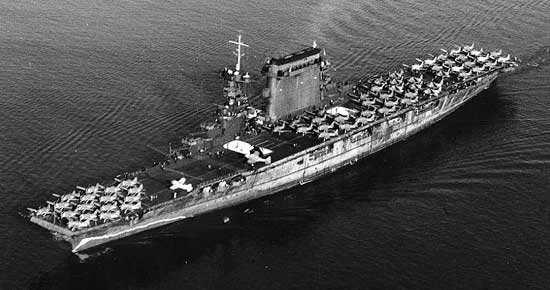 |
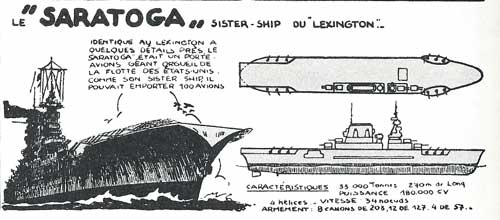 |
The WWII US Navy aircraft carrier USS Saratoga is shown on a technical table in the story LES JAPS ATTAQUENT |
USS Saratoga (CV-3) was a Lexington-class aircraft carrier built for the United States Navy during the 1920s. Originally designed as a battlecruiser, she was converted into one of the Navy's first aircraft carriers during construction to comply with the Washington Naval Treaty of 1922. The ship entered service in 1928 and was assigned to the Pacific Fleet for her entire career. Saratoga and her sister ship, Lexington, were used to develop and refine carrier tactics in a series of annual exercises before World War II. On more than one occasion these included successful surprise attacks on Pearl Harbor, Hawaii. She was one of three prewar US fleet aircraft carriers, along with Enterprise and Ranger, to serve throughout World War II.
In 1943, Saratoga supported Allied forces involved in the New Georgia Campaign and invasion of Bougainville in the northern Solomon Islands and her aircraft twice attacked the Japanese base at Rabaul in November. Early in 1944, her aircraft provided air support during the Gilbert and Marshall Islands Campaign before she was transferred to the Indian Ocean for several months to support the British Eastern Fleet as it attacked targets in Java and Sumatra. After a brief refit in mid-1944, the ship became a training ship for the rest of the year.
In early 1945, Saratoga participated in the Battle of Iwo Jima as a dedicated night fighter carrier. Several days into the battle, she was badly damaged by kamikaze hits and was forced to return to the United States for repairs. While under repair, the ship, now increasingly obsolete, was permanently modified as a training carrier with some of her hangar deck converted into classrooms. Saratoga remained in this role for the rest of the war and was used to ferry troops back to the United States after the Japanese surrender in August. In mid-1946, the ship was a target for nuclear weapon tests during Operation Crossroads. She survived the first test with little damage, but was sunk by the second test.
.
|
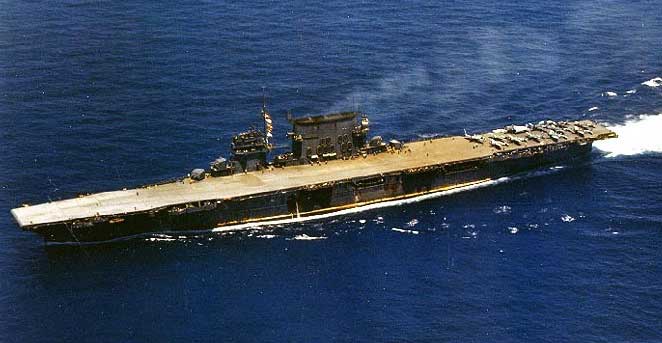 |
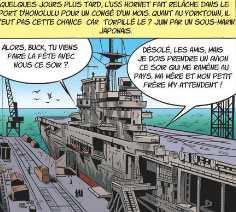 |
The WWII US Navy aircraft carrier USS Hornet is shown by Marniquet in the short story L'INEVITABLE RENCONTRE published in 2017 as inedit story on the comic SPIROU #4108 dedicated to the 70th years of the Buck Danny adventures. |
USS Hornet (CV-8), the seventh ship to carry the name Hornet, was a Yorktown-class aircraft carrier of the United States Navy. During World War II in the Pacific Theater, she launched the Doolittle Raid on Tokyo and participated in the Battle of Midway and the Buin-Faisi-Tonolai Raid. In the Solomon Islands campaign she was involved in the capture and defense of Guadalcanal and the Battle of the Santa Cruz Islands where she was irreparably damaged and sunk by enemy aircraft carrier torpedo and dive bombers. Hornet was in service for a year and six days and was the last US fleet carrier ever sunk by enemy fire. For these actions, she was awarded four service stars, a citation for the Doolittle Raid in 1995, and her Torpedo Squadron 8 received a Presidential Unit Citation for extraordinary heroism for the Battle of Midway.
.
|
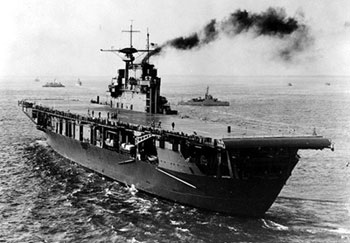 |
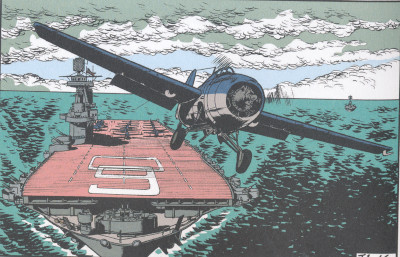 |
The WWII US Navy aircraft carrier USS Enterprise is shown in the two albums story BUCK DANNY ORIGINES - LE PILOTE A L'AILE BRISEE published in 2022. |
USS Enterprise (CV-6) was a Yorktown-class carrier built for the United States Navy during the 1930s. She was the seventh U.S. Navy vessel of that name. Colloquially called "The Big E", she was the sixth aircraft carrier of the United States Navy. Launched in 1936, she was one of only three American carriers commissioned before World War II to survive the war. She participated in more major actions of the war against Japan than any other United States ship, and was the most decorated U.S. ship of World War II. She was also the first American ship to sink a full-sized enemy warship after the Pacific War had been declared when her aircraft sank the Japanese submarine I-70 on 10 December 1941. By the end of the war, her planes and guns had downed 911 enemy planes, sunk 71 ships, and damaged or destroyed 192 more. Despite efforts made by the public after the war to turn Enterprise into a museum ship, Enterprise was ultimately scrapped from 1958 to 1960.
.
|
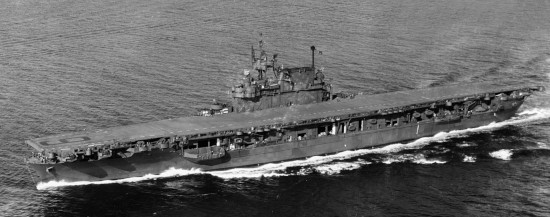 |
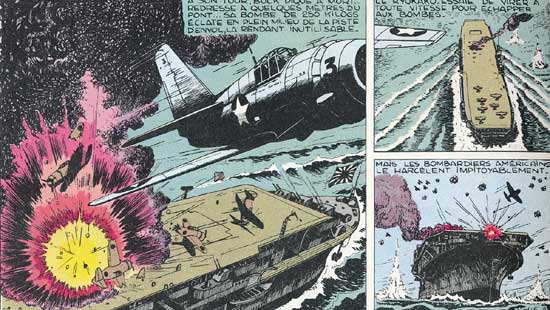 |
The WWII Imperial Japanes Navy aircraft carrier Shoho (his name was wrongly translater in Ryukaku) is destroyed in the story LES JAPS ATTAQUENT |
Shoho (Japanese: Auspicious Phoenix or Happy Phoenix) was a light aircraft carrier of the Imperial Japanese Navy. Originally built as the submarine support ship Tsurugizaki in the late 1930s, she was converted before the Pacific War into an aircraft carrier and renamed. Completed in early 1942, the ship supported the invasion forces in Operation MO, the invasion of Port Moresby, New Guinea, and was sunk by American carrier aircraft on her first combat operation during the Battle of the Coral Sea on 7 May. Shoho was the first Japanese aircraft carrier to be sunk during World War II..
|
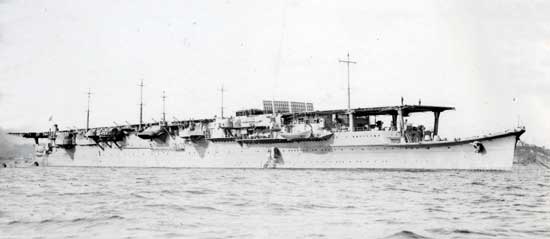 |
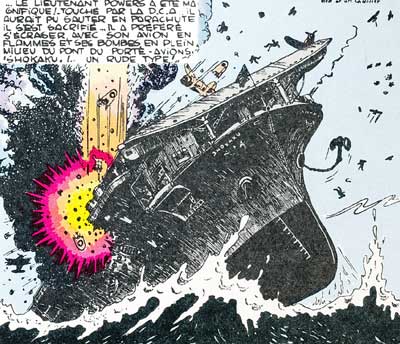 |
The WWII Imperial Japanes Navy aircraft carrier Shokaku is also destroyed in the story LES JAPS ATTAQUENT .
|
Shokaku (Japanese: Soaring Crane) was an aircraft carrier of the Imperial Japanese Navy, the lead ship of her class. Along with her sister ship Zuikaku, she took part in several key naval battles during the Pacific War, including the attack on Pearl Harbor, the Battle of the Coral Sea and the Battle of the Santa Cruz Islands before being torpedoed and sunk by an American submarine at the Battle of the Philippine Sea
|
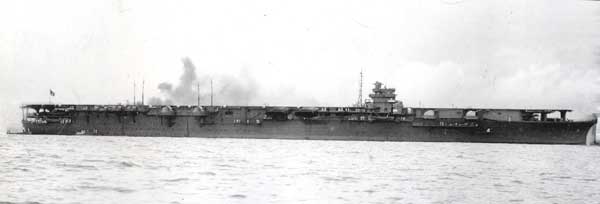 |
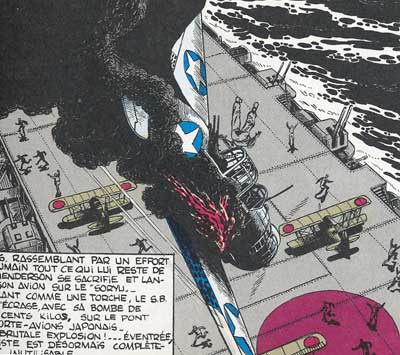 |
The WWII Imperial Japanes Navy aircraft carrier Soryu is also shown in the story LES MYSTERES DE MYDWAY. |
Soryu (meaning Blue (or Green) Dragon) was an aircraft carrier
built for the Imperial Japanese Navy (IJN) during the mid 1930s. A sister ship, Hiryu, was intended to follow
Soryu, but Hiryu's design was heavily modified and she is often considered to be a separate class. Soryu's
aircraft were employed in operations during the Second Sino Japanese War in the late 1930s and supported the
Japanese invasion of French Indochina in mid 1940. During the first months of the Pacific War, she took part in
the attack on Pearl Harbor, the Battle of Wake Island, and supported the conquest of the Dutch East Indies. In
February 1942, her aircraft bombed Darwin, Australia, and she continued on to assist in the Dutch East Indies
campaign. In April, Soryu's aircraft helped sink two British heavy cruisers and several merchant ships during
the Indian Ocean raid.
After a brief refit, Soryu and three other carriers of the First Air Fleet (Kido Butai) participated in the
Battle of Midway in June 1942. After bombarding American forces on Midway Atoll, the carriers were attacked by
aircraft from the island and the carriers Enterprise, Hornet, and Yorktown. Dive bombers from Yorktown crippled
Soryu and set her afire. She could not be salvaged and was ordered to be scuttled so as to allow her attendant
destroyers to be released for further operations. She sank with the loss of 711 officers and enlisted men of the
1,103 aboard. The loss of Soryu and three other IJN carriers at Midway was a crucial strategic defeat for Japan
and contributed significantly to the Allies' ultimate victory in the Pacific.
|
 |
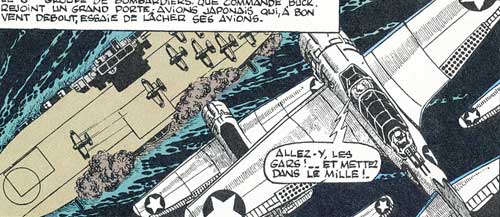 |
The WWII Imperial Japanes Navy aircraft carrier Kaga is also shown and destroyed in the story LES MYSTERES DE MYDWAY. |
Kaga was an aircraft carrier of the Imperial Japanese Navy (IJN),
the third to enter service, named after the former Kaga Province in present-day Ishikawa Prefecture. Originally
intended to be one of two Tosa-class battleships, Kaga was converted under the terms of the Washington Naval
Treaty to an aircraft carrier as the replacement for the battlecruiser Amagi, which had been damaged during the
1923 Great Kanto earthquake. Kaga was rebuilt in 1933–35, increasing her top speed, improving her exhaust systems, and adapting her flight decks to more modern, heavier aircraft.
Kaga's aircraft first supported Japanese troops in China during the Shanghai Incident of 1932 and participated
in the Second Sino-Japanese War in the late 1930s. With other carriers, she took part in the Pearl Harbor raid
in December 1941 and the invasion of Rabaul in the Southwest Pacific in January 1942. The following month her
aircraft participated in a combined carrier airstrike on Darwin, Australia, helping secure the conquest of the
Dutch East Indies by Japanese forces. She missed the Indian Ocean raid in April as she had to return to Japan
for permanent repairs after hitting a reef in February.
Following repairs, Kaga rejoined the 1st Air Fleet for the Battle of Midway in June 1942. After bombarding
American forces on Midway Atoll, Kaga and three other IJN carriers were attacked by American aircraft from
Midway and the carriers Enterprise, Hornet, and Yorktown. Dive bombers from Enterprise severely damaged Kaga;
when it became obvious she could not be saved, she was scuttled by Japanese destroyers to prevent her from
falling into enemy hands. The loss of four large attack carriers, including Kaga at Midway, was a crucial
setback for Japan, and contributed significantly to that nation's ultimate defeat.
|
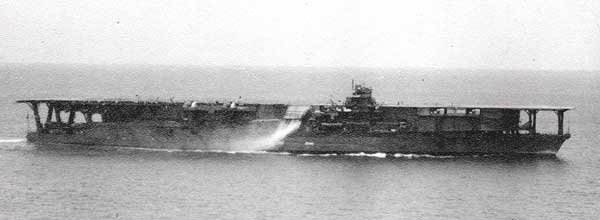 |
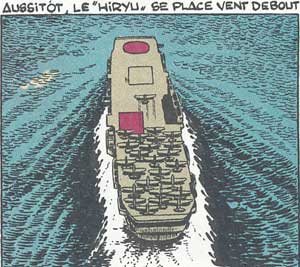 |
The WWII Imperial Japanes Navy aircraft carrier Hiryu is also shown in the story LES MYSTERES DE MYDWAY. |
The WWII Japanese aircraft carrier Hiryu under attack from US Navy aircraft is represented by Marniquet in the short story L'INEVITABLE RENCONTRE published in 2017 as inedit story on the comic SPIROU #4108 dedicated to the 70th years of the Buck Danny adventures. |
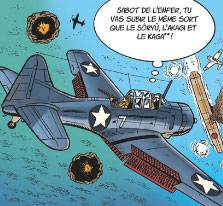
|
 |
Hiryu (Flying Dragon) was an aircraft carrier built for the
Imperial Japanese Navy (IJN) during the 1930s. The only ship of her class, she was built to a modified Soryu
design. Her aircraft supported the Japanese invasion of French Indochina in mid-1940. During the first month of
the Pacific War, she took part in the attack on Pearl Harbor and the Battle of Wake Island. The ship supported
the conquest of the Dutch East Indies in January 1942. The following month, her aircraft bombed Darwin,
Australia, and continued to assist in the Dutch East Indies campaign. In April, Hiryu's aircraft helped sink two British heavy cruisers and several merchant ships during the Indian Ocean raid.
After a brief refit, Hiryu and three other fleet carriers of the First Air Fleet (Kido Butai) participated in
the Battle of Midway in June 1942. After bombarding American forces on the atoll, the carriers were attacked by
aircraft from Midway and the carriers USS Enterprise, Hornet, and Yorktown. Dive bombers from Yorktown and Enterprise crippled Hiryu and set her afire. She was scuttled the following day after it became clear that she
could not be salvaged. The loss of Hiryu and three other IJN carriers at Midway was a crucial strategic defeat
for Japan and contributed significantly to the Allies' ultimate victory in the Pacific.
|
|
Essex-class aircraft carrier |
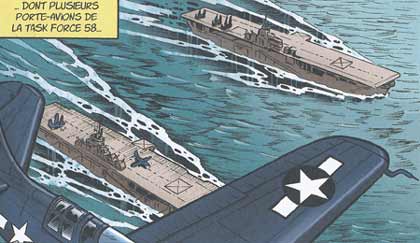 |
Two not identifiable US Navy Essex class aircraftcarrier of the Task Force 58 are shown by Arroyo in the story LES FANTôMES DU SOLEIL LEVANT |
The Essex class was a class of aircraft carriers of the United States Navy that constituted the 20th century's most numerous class of capital ships. The class consisted of 24 vessels, which came in both "short-hull" and "long-hull" versions. Thirty-two ships were originally ordered; however as World War II wound down, six were canceled before construction, and two were canceled after construction had begun. No Essex-class ships were lost to enemy action, despite several vessels sustaining very heavy damage. The Essex-class carriers were the backbone of the U.S. Navy's combat strength during World War II from mid-1943 on, and, along with the addition of the three Midway-class carriers just after the war, continued to be the heart of U.S. naval strength until the supercarriers began to come into the fleet in numbers during the 1960s and 1970s.
|
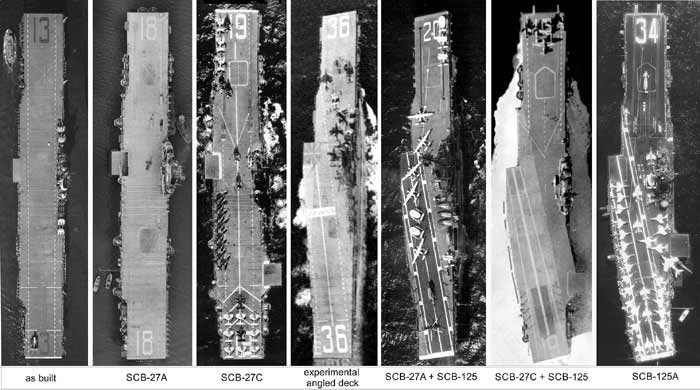 |
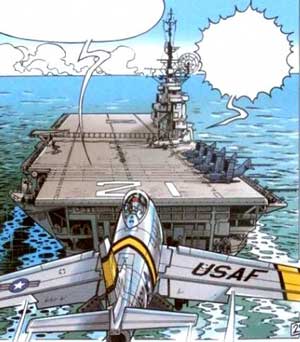 |
The US Navy aircraft carrier USS Boxer is shown during the Korean war in the new Buck Danny Classical adventures SABRE SUR LA COREE and DUEL SUR MIG ALLEY |
USS Boxer (CV/CVA/CVS-21) was one of 24 Essex-class aircraft carriers of the United States (U.S.) Navy, and the fifth ship to be named for the HMS Boxer. She was launched on 14 December 1944 and christened by the daughter of a US Senator from Louisiana.
Commissioned too late to see any combat in World War II, Boxer spent much of her career in the Pacific Ocean seeing 10 tours in the western Pacific. Her initial duties involved mostly training and exercises, including launching the first carrier-based jet aircraft, but demobilization prevented much activity in the late 1940s. At the outbreak of the Korean War, she was used as an aircraft transport before arriving off Korean Waters as the third U.S. Carrier to join the force. She supported the Inchon landings and subsequent invasion of North Korea, and was among the ships that provided support during the Chinese counteroffensive against an under-prepared and spread out United Nations (UN) force. She saw three subsequent combat tours in Korea conducting close air support and strategic bombing in support of UN ground troops fighting along the 38th Parallel, as the battles lines had largely solidified by this time. She was awarded eight battle stars for her service in Korea.
After the Korean War, Boxer saw a variety of duties, including as an anti-submarine warfare carrier and an amphibious assault platform. She participated in a number of training exercises including Operation Hardtack and Operation Steel Pike, as well as several contingencies including Operation Powerpack and the Cuban Missile Crisis. In her later years, she served as a pickup ship for spacecraft during the Apollo program as well as an aircraft transport to troops during the Vietnam War.
Although she was extensively modified internally as part of her conversion to an LPH, external modifications were minor, so throughout her career Boxer retained the classic appearance of a World War II Essex-class ship. She was decommissioned on 1 December 1969 after 25 years of service and sold for scrap.
|
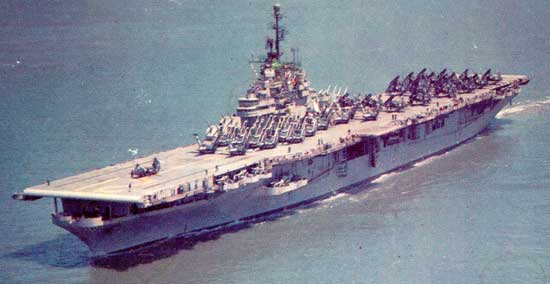 |
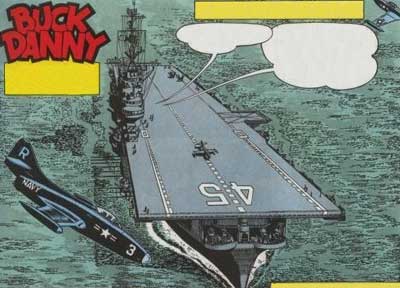 |
Buck Danny and his friends are assigned for an exchange pilots program to the US Navy aircraft carrier USS Valley Forge in the story UN AVION N'EST PAS RENTRÈ |
The USS Valley Forge is also shown in the story PATROUILLE A L'AUBE.
|
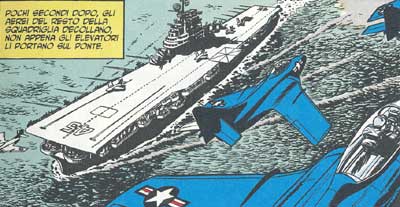 |
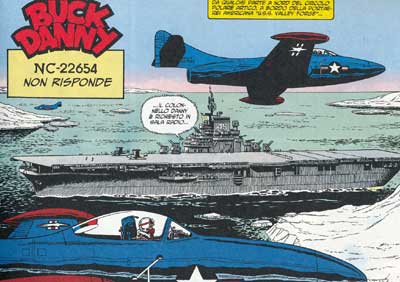 |
Back Danny and his comrades are still on the USS Valley Forge in the story NCC-22654 NE REPOND PLUS |
The USS Valey Forge is also shown in the story MENACE AU NORD.
|
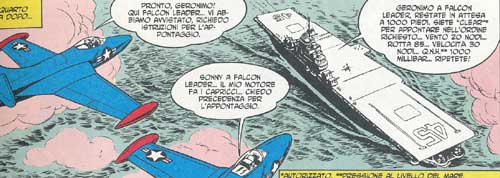 |
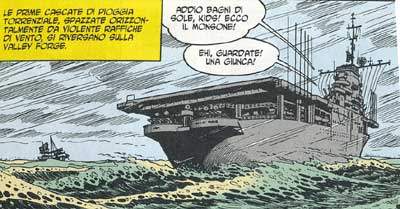 |
The USS Valley Forge is also well represented in the adventures ALERTE EN MALAISE and LE TIGRE DE MALAISIE
|
The Valley Forge is also well depicted by Arroyo on a short humorous Buck Danny story by Zumbiehl and Arroyo published in the Spirou magazine: volume #4000 and # 4001/4002. |
 |
 |
The Valley Forge is also present in the Buck Danny Classic #8 story LE REPAIRE DE L'AIGLE by Le Bras, Mrniquet, Zumbiehl. |
USS Valley Forge (CV/CVA/CVS-45, LPH-8) was one of 24 Essex-class aircraft carriers built during and shortly after World War II for the United States Navy. The ship was the first US Navy ship to bear the name, and was named for Valley Forge, the 1777–1778 winter encampment of General George Washington's Continental Army. Valley Forge was commissioned in November 1946, too late to serve in World War II, but saw extensive service in the Korean War and the Vietnam War. She was reclassified in the early 1950s as an attack carrier (CVA), then to an antisubmarine carrier (CVS), and finally to an amphibious assault ship (LPH), carrying helicopters and marines. As a CVS she served in the Atlantic and Caribbean. She was the prime recovery vessel for an early unmanned Mercury space mission. After conversion to an LPH she served extensively in the Vietnam War. Valley Forge was awarded eight battle stars for Korean War service and nine for Vietnam War service, as well as three Navy Unit Commendations.
Although she was extensively modified internally as part of her conversion to an amphibious assault ship, external modifications were minor, so throughout her career Valley Forge retained the classic appearance of a World War II Essex-class ship. She was decommissioned in 1970, and sold for scrap in 1971.
|
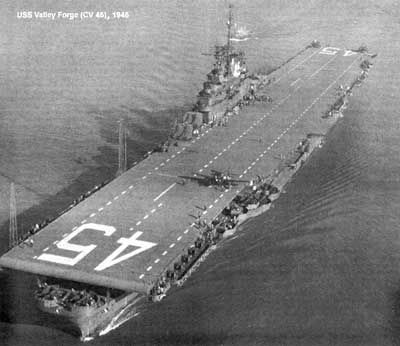 |
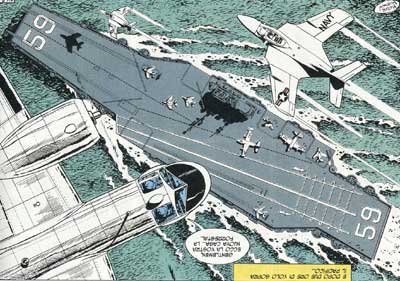 |
The US Navy aircraft carrier USS Forrestal is well represented in the adventures SOS SOUCOUPES VOLANTES! and UN PROTOTYPE A DISPARU.
|
The USS Forrestal is also shown in the story TOP SECRET.
|
 |
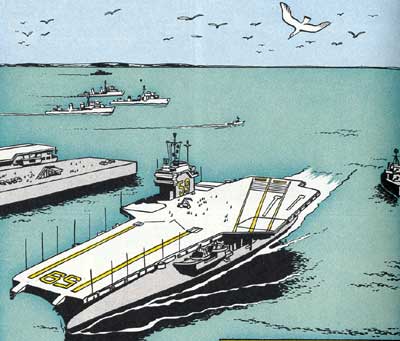 |
Buck Danny and his friends are also on board of the USS Forrestal in the adventures OPERATION MERCURY and LES VOLEURS DE SATELLITES.
|
The USS Forrestal is also shown at the beginning of the story X-15.
|
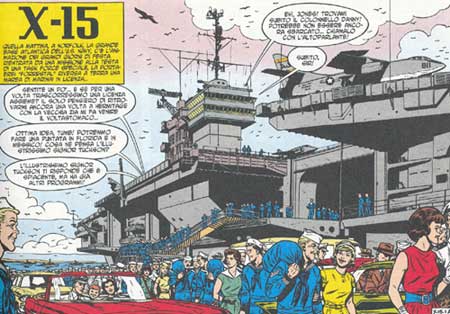 |
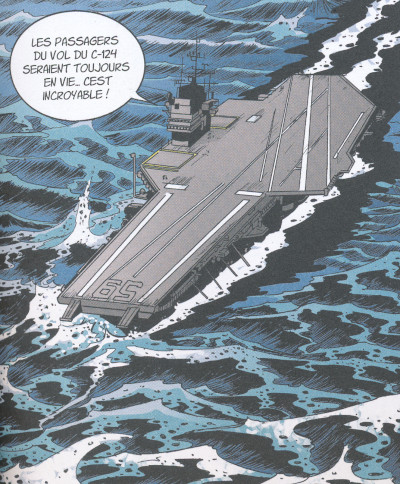 |
Buck Danny and his friends are on board of the USS Forrestal in the Classic N.9 adventures LE VOL DU RAPIER in 1958.
|
USS Forrestal (CV-59), formerly AVT-59 and CVA-59, was a supercarrier named after the first Secretary of Defense James Forrestal. Commissioned in 1955, she was the first completed supercarrier, and was the lead ship of her class. The other carriers of her class were the USS Saratoga, USS Ranger and USS Independence. She superseded the World War II Japanese carrier Shinano as the largest aircraft carrier ever built in terms of full load displacement and was the first to specifically support jet aircraft.
The ship was affectionately called "The FID", because James Forrestal was the first ever Secretary of Defense, FID standing for "First In Defense". This is also the slogan on the ship's insignia and patch. She was also informally known in the fleet as the "USS Zippo" and "Forest Fire" or "Firestal" because of a number of highly publicized fires on board, most notably a 1967 incident in which 134 sailors died and an additional 161 were injured.
Forrestal served for nearly four decades in the Atlantic, Mediterranean, and Pacific. She was decommissioned in 1993, and made available as a museum. Attempts to save her were unsuccessful, however, and in February 2014 she was towed to Brownsville, Texas to be scrapped.
|
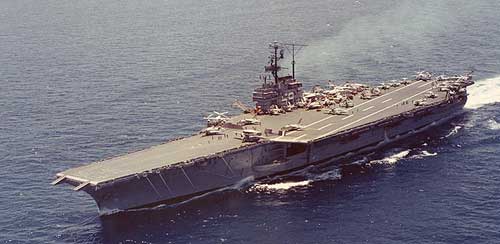 |
|
USS Franklin D. Roosevelt (CVA-42) |
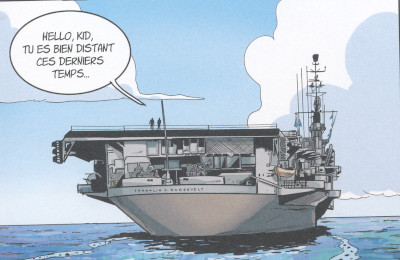 |
The US Navy aircraft carrier USS Franklin D. Roosevelt is shown at the end of the story MOLOTOK-41 NE REPOND PLUS. |
USS Franklin D. Roosevelt (CVB/CVA/CV-42) was the second of three Midway-class aircraft carriers. To her crew, she was known as "Swanky Franky," "Foo-De-Roo," or "Rosie," with the last nickname probably the most popular. Roosevelt spent most of her active deployed career operating in the Mediterranean Sea as part of the United States Sixth Fleet. The ship was decommissioned in 1977 and was scrapped shortly afterward. She was the first aircraft carrier of the United States Navy to be named in honor of a president of the United States.
| 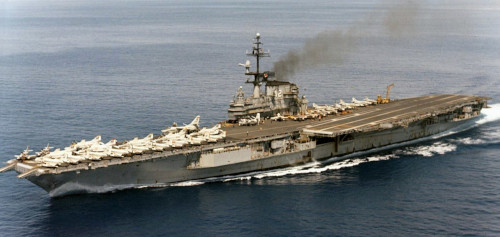 |
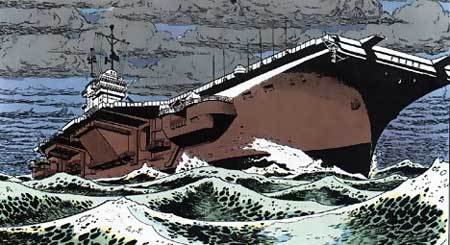 |
The US Navy aircraft carrier USS Saratoga is shown in the stories LE RETOUR DES TIGRES VOLANTS and LES TIGRES VOLANTS A LA RESCOUSSE!. |
The US Navy aircraft carrier USS Saratoga is also show by Arroyo in the Buck Danny Classic Adventure #5 titled OPÉRATION RIDEAU DE FER. |
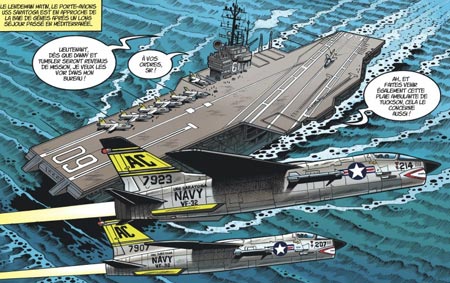 |
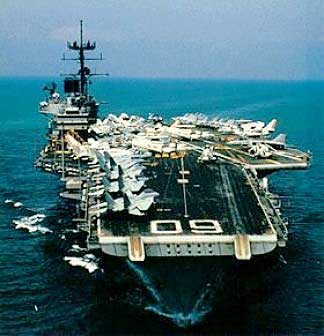 |
USS Saratoga (CV/CVA/CVB-60), was one of four Forrestal-class supercarriers built for the United States Navy in the 1950s. Saratoga was the sixth U.S. Navy ship, and the second aircraft carrier, to be named for the Battle of Saratoga in the American Revolutionary War.
Commissioned in 1956, she spent most of her career in the Mediterranean, but also participated during the Vietnam War, receiving one battle star for her service. One of her last operational duties was to participate in Operation Desert Storm.
Saratoga was decommissioned in 1994, and had been stored at Naval Station Newport in Newport, Rhode Island. Multiple unsuccessful attempts were made to preserve her as a museum ship. The Navy is paying ESCO Marine of Brownsville, Texas, one cent to take the ship for dismantling and recycling. On 15 September 2014, ex-Saratoga arrived in Brownsville, Texas, to be scrapped.
|
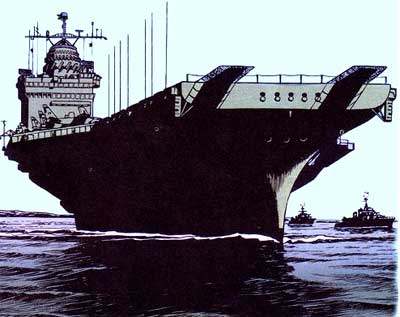 |
Buck Danny and his comrades are on board of the nuclear powered aircraft carrier USS Enterprise in the story LES MYSTERE DES AVIONS FANTOMES. |
The USS Enterprise is also represented in the adventures ALERTE ATOMIQUE and L'ESCADRILLE DE LA MORT
|
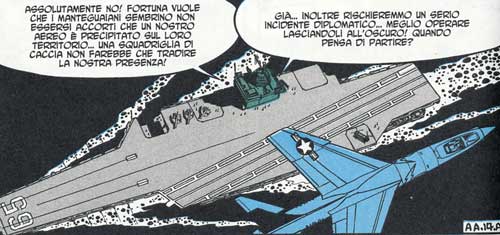 |
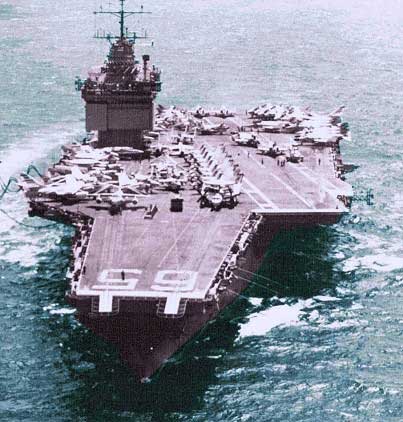 |
USS Enterprise (CVN-65), formerly CVA(N)-65, is an inactive United States Navy aircraft carrier. She was the world's first nuclear-powered aircraft carrier and the eighth United States naval vessel to bear the name. Like her predecessor of World War II fame, she is nicknamed "Big E". At 1,123 ft (342 m), she is the longest naval vessel in the world, a record which still stands. Her 93,284-long-ton (94,781 t) displacement ranked her as the 11th-heaviest supercarrier, after the 10 carriers of the Nimitz class. Enterprise had a crew of some 4,600 service members.
The only ship of her class, Enterprise was, at the time of inactivation, the third-oldest commissioned vessel in the United States Navy after the wooden-hulled USS Constitution and USS Pueblo. She was originally scheduled for decommissioning in 2014 or 2015, depending on the life of her reactors and completion of her replacement, USS Gerald R. Ford, but the National Defense Authorization Act for Fiscal Year 2010 slated the ship's retirement for 2013, when she would have served for 51 consecutive years, longer than any other U.S. aircraft carrier.
Enterprise's home port was Naval Station Norfolk, Virginia as of September 2012. Her final deployment, the last before her inactivation, began on 10 March 2012 and ended 4 November 2012. She was inactivated on 1 December 2012, with her official decommissioning taking place sometime in 2016 after the completion of an extensive terminal offload program currently underway. The name has been adopted by the future Gerald R. Ford-class aircraft carrier USS Enterprise (CVN-80).
As of 2015, Enterprise is still a commissioned United States Navy ship, but is inactive. She has undergone enough of the four-year-long inactivation process to render her unfit for further military service. Inactivation removes fuel, fluids, furnishings, tools, fittings, and oil and de-energizes the ship's electrical system. Enterprise has already been cut open to allow the removal of usable systems.
|
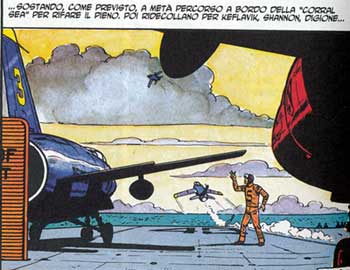 |
The US Navy Blue Angels Aerobatic Team make a short logistic stop on board of the USS Coral Sea in the story LES ANGES BLEUS
|
USS Coral Sea (CV/CVB/CVA-43), a Midway-class aircraft carrier, was the third ship of the United States Navy to be named for the Battle of the Coral Sea. She earned the affectionate nickname "Ageless Warrior" through her long career. Initially classified as an aircraft carrier with hull classification symbol CV-43, the contract to build her was awarded to Newport News Shipbuilding of Newport News, Virginia on 14 June 1943. She was reclassified as a "Large Aircraft Carrier" with hull classification symbol CVB-43 on 15 July 1943. Her keel was laid down on 10 July 1944. She was launched on 2 April 1946 sponsored by Mrs. Thomas C. Kinkaid, and commissioned on 1 October 1947 with Captain A.P. Storrs III in command.
Before 8 May 1945, the aircraft carrier CVB-42 had been known as USS Coral Sea; after that date, CVB-42 was renamed in honor of Franklin D. Roosevelt, the late President, and CVB-43 was named Coral Sea.
Coral Sea was the last U.S Navy carrier to be completed with a straight flight deck, with an angled flight deck added on during later modernizations. All other U.S Navy carriers since have had the angled deck included as part of the ship's construction.
|
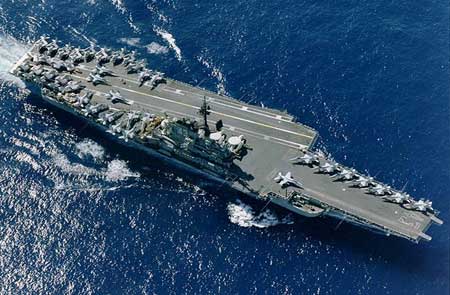 |
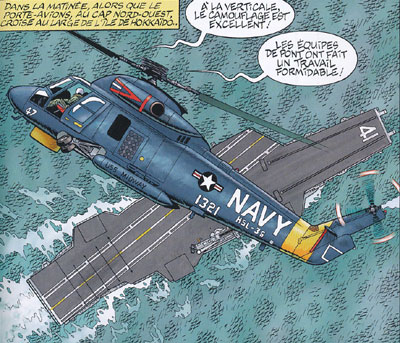 |
The USS Midway is well depicted by Bergese in the story LES OISEAUX NOIRS
|
USS Midway (CVB/CVA/CV-41) was an aircraft carrier of the United States Navy, the lead ship of her class. Commissioned a week after the end of World War II, Midway was the largest ship in the world until 1955, as well as the first U.S. aircraft carrier too big to transit the Panama Canal. A revolutionary hull design, based on the planned Montana-class battleship, gave her better maneuverability than previous carriers.[verification needed] She operated for an unprecedented 47 years, during which time she saw action in the Vietnam War and served as the Persian Gulf flagship in 1991's Operation Desert Storm. Decommissioned in 1992, she is now a museum ship at the USS Midway Museum, in San Diego, California, and the only remaining U.S. aircraft carrier of the World War II era that is not an Essex-class aircraft carrier.
|
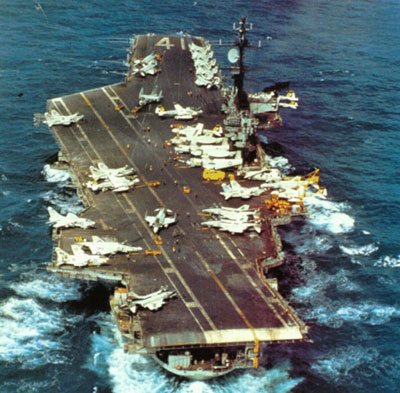 |
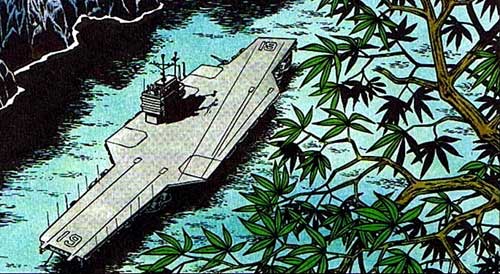 |
Buck Danny and friends are on board of the USS Ranger in the adventures LA VALLEE DE LA MORT VERTE, REQUINS EN MER DE CHINE and LA REINE FANTOME "GHOST QUEEN". |
The USS Ranger is also shown in the story LES OISEAUX NOIRS with a reference that in 1964 a modified U-2C performed a recoinasse mission from this aircraft carrier. |
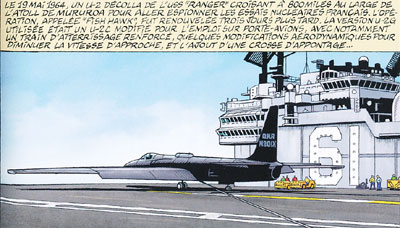 |
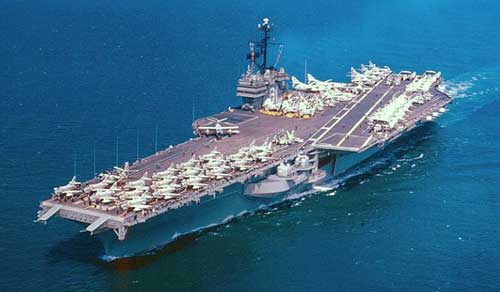 |
The seventh USS Ranger (CV/CVA-61) was one of four Forrestal-class supercarriers built for the United States Navy in the 1950s. Although all four ships of the class were completed with angled decks, Ranger had the distinction of being the first US carrier built from the beginning as an angled-deck ship.
Commissioned in 1957, she served extensively in the Pacific, especially the Vietnam War, for which she earned 13 battle stars. Near the end of her career, she also served in the Indian Ocean and Persian Gulf.
Ranger appeared on television in The Six Million Dollar Man and Baa Baa Black Sheep, and in the films Top Gun, Star Trek IV: The Voyage Home (standing in for the carrier Enterprise), and Flight of the Intruder.
Ranger was decommissioned in 1993, and was stored at Bremerton, Washington until March 2015. She is currently under tow to Brownsville, Texas, for scrapping.
|
|
USS John F. Kennedy (CVA-67) |
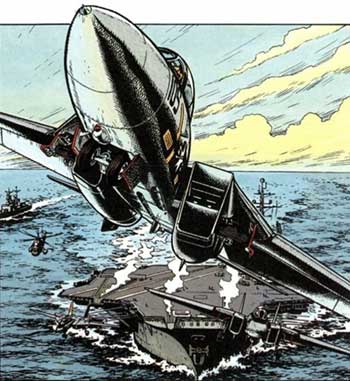 |
The US Navy aircraft carrier USS John F. Kennedy is represented in the stories MISSION APOCALYPSE, LES PILOTES DE L'ENFER and LE FEU DU CIEL . |
Buck Danny and his friends are still on board of the USS John F. Kennedy in the story LES AGRESSEURS
|
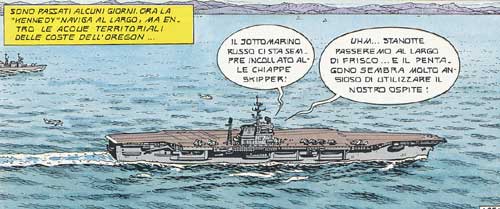 |
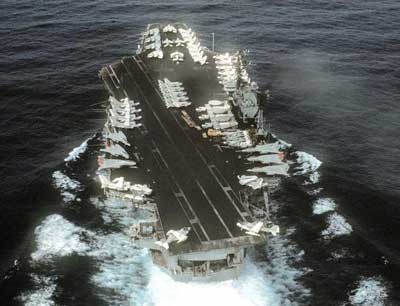 |
USS John F. Kennedy (CV-67) (formerly CVA-67) is the only ship of her class (a variant of the Kitty Hawk class of aircraft carrier) and the last conventionally powered carrier built for the United States Navy.[3] The ship is named after the 35th President of the United States, John F. Kennedy, and is nicknamed "Big John". Kennedy was originally designated a CVA (fixed wing attack carrier); however, the designation was changed to CV to denote that the ship was capable of anti-submarine warfare, making her an all-purpose carrier.
After nearly 40 years of service in the United States Navy, Kennedy was officially decommissioned on 1 August 2007. She is berthed at the NAVSEA Inactive Ships On-site Maintenance facility in Philadelphia. She is available for donation as a museum and memorial to a qualified organization. The name has been adopted by the future Gerald R. Ford-class aircraft carrier John F. Kennedy (CVN-79).
|
|
USS Theodore Roosevelt (CVN-71) |
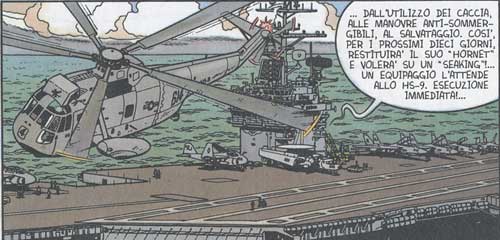 |
The nuclear powered Supercarrier USS Theodore Roosevelt is well depicted in the story LES SECRETS DE LA MER NOIRE |
USS Theodore Roosevelt (CVN-71) (also known by crewmembers as "the Big Stick" or within the navy simply as TR) is the fourth Nimitz-class aircraft carrier. Her radio call sign is Rough Rider, the name of President Theodore Roosevelt's volunteer cavalry unit during the Spanish–American War. She was launched in 1984, saw her first action during Operation Desert Storm in 1991. She is currently engaged in a round-the-world deployment.
Initially, U.S. President Gerald Ford cancelled the order for CVN-71 in 1976 and substituted two CVV-type medium-sized, conventional-powered carriers that were expected to operate V/STOL aircraft. The existing T-CBL design formed the basis for the new CVV, serving as a replacement for the aging Midway-class aircraft carrier, while capable of operating all existing conventional carrier aircraft. This capability to operate conventional aircraft proved important as the hoped-for supersonic V/STOL fighters did not come to fruition at the time. In any case, construction of the proposed CVV medium-sized carrier never took place.
Authorization for CVN-71 was further delayed when President Jimmy Carter vetoed the 1979 Fiscal Year Department of Defense authorization bill because of the inclusion of this Nimitz-class nuclear supercarrier in the U.S. Navy's shipbuilding program. Because of the international crisis that required the increased deployment of U.S. aircraft carrier battle groups to the Indian Ocean, President Carter reversed his stand on Nimitz-class nuclear supercarriers, and CVN-71 was subsequently authorized under the 1980 Fiscal Year authorization bill for the U.S. Department of Defense.
|
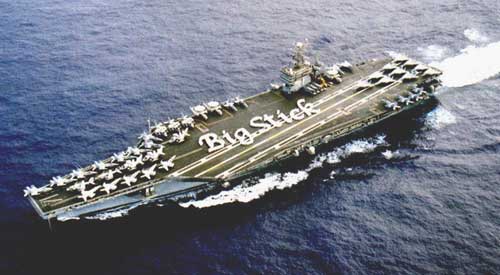 |
|
Admiral Flota Sovetskovo Soyuza Kuznetsov |
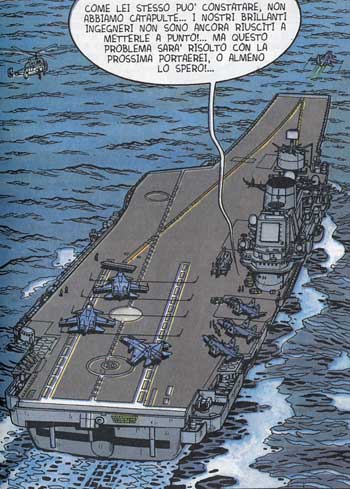 |
The Russian aircraft carrier Admiral Kuznetsov is represented in the story LES SECRETS DE LA MER NOIRE |
The Russian aircraft carrier Admiral Kuznetsov is also represented by Formosa in the story OPERATION VEKTOR and LE PACTE! |
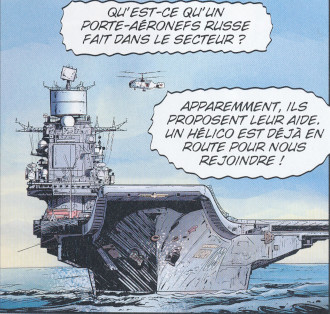 |
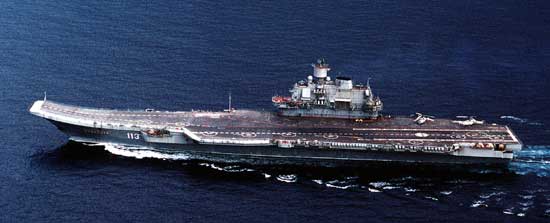 |
Admiral Flota Sovetskovo Soyuza Kuznetsov (Admiral of the Fleet of the Soviet Union Kuznetsov) was built by the Black Sea Shipyard, the sole manufacturer of Soviet aircraft carriers, in Mykolaiv within the Ukrainian Soviet Socialist Republic. The initial name of the ship was Riga; she was launched as Leonid Brezhnev, embarked on sea trials as Tbilisi, and finally named Kuznetsov. She is an aircraft cruiser (heavy aircraft-carrying missile cruiser (TAVKR) in Russian classification) serving as the flagship of the Russian Navy.
She was originally commissioned in the Soviet Navy, and was intended to be the lead ship of her class, but the only other ship of her class, Varyag, was never completed or commissioned by the Soviet, Russian or Ukrainian navy. Later, this second hull was sold to the People's Republic of China by Ukraine, completed in Dalian and launched as Liaoning. Kuznetsov was named after the Admiral of the Fleet of the Soviet Union Nikolay Gerasimovich Kuznetsov.
|
The nuclear powered supercarrier USS Eisenhower is depicted in the story L'ESCADRILLE FANTOME
.
|
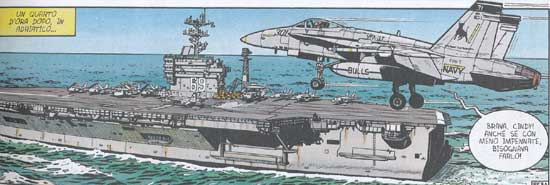 |
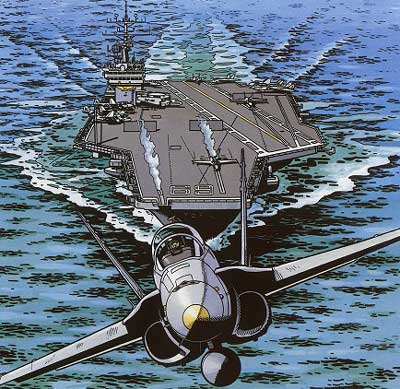 |
The nuclear powered supercarrier USS Eisenhower is well represented in the stories ZONE INTERDITE and TONNERE SUR LA CORDILLERE |
USS Dwight D. Eisenhower (CVN-69) ("Ike") is a nuclear-powered aircraft carrier currently in service with the United States Navy. Commissioned in 1977, the ship is the second of the ten Nimitz-class aircraft carriers currently in service, and is the first ship named after the 34th President of the United States, Dwight D. Eisenhower. The vessel was initially named simply as USS Eisenhower, much like the lead ship of the class Nimitz, but the name was changed to its present form on 25 May 1970. The carrier, like all others of her class, was constructed at Newport News Shipbuilding Company in Virginia, with the same design as the lead ship, although the ship has been overhauled twice to bring her up to the standards of those constructed more recently.
Since commissioning, Dwight D. Eisenhower has participated in deployments including Operation Eagle Claw during the Iran hostage crisis in 1980, as well as the Gulf War in the 1990s, and more recently in support of U.S. military operations in Iraq and Afghanistan.
|
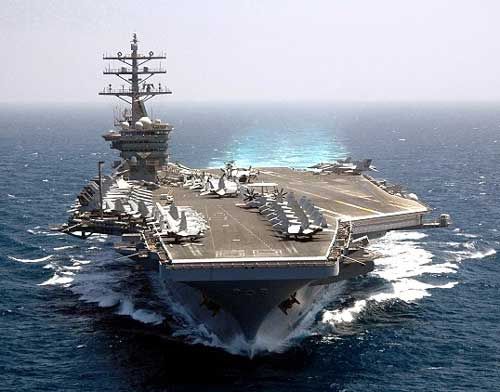 |
|
USS Harry Truman (CVN-75) |
 |
The US Navy nuclear powered supercarrier USS Harry Truman is shown in the adventure MYSTÈRE EN ANTARCTIQUE |
USS Harry S. Truman (CVN-75) is the eighth Nimitz-class aircraft carrier of the United States Navy, named after the 33rd President of the United States, Harry S. Truman. The ship's callsign is Lone Warrior, and she is currently homeported at Naval Station Norfolk, Virginia.
Harry S. Truman was launched on 14 September 1996 by Newport News Shipbuilding, Newport News, Virginia, and commissioned on 25 July 1998 with Captain Thomas Otterbein in command. President Bill Clinton was the keynote speaker, and other notable attendees and speakers included Missouri Representative Ike Skelton, Missouri Governor Mel Carnahan, Secretary of Defense William Cohen and Secretary of the Navy John H. Dalton.
Harry S. Truman was initially the flagship of Carrier Group Two and, beginning 1 October 2004, of Carrier Strike Group Ten.
Beginning in 2001, the Harry S. Truman Carrier Battle Group participated in Operation Joint Endeavor, Operation Deny Flight, Operation Southern Watch, Operation Enduring Freedom – Afghanistan, Operation Iraqi Freedom, Summer Pulse '04, and NATO Operation Medshark/Majestic Eagle '04.
|
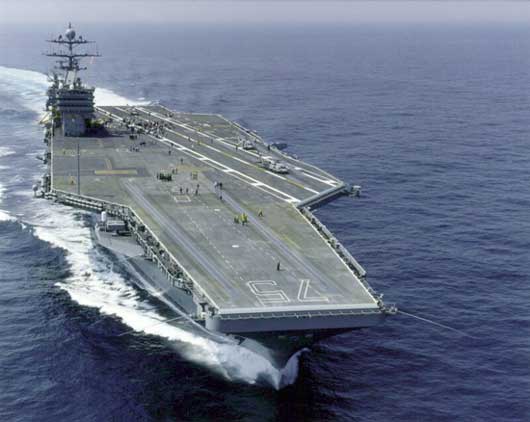 |
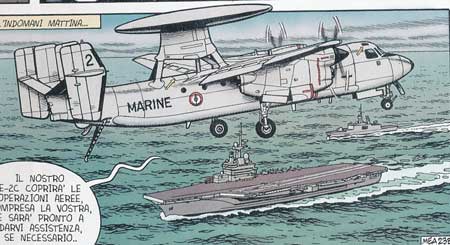 |
The French Navy nuclear powerd aircraft carrier Charles De Gaulle is well represented in the story MYSTÈRE EN ANTARCTIQUE . |
The Charles De Gaulle is also well represented by Formosa in the adventure VOSTOK NE REPOND PLUS, OPERATION VEKTOR and LE PACTE!. |
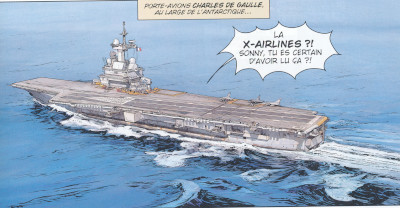 |
Charles de Gaulle is the flagship of the French Navy (Marine Nationale) and the largest Western European warship currently in commission. She is the tenth French aircraft carrier, the first French nuclear-powered surface vessel, and the first and so far only nuclear-powered carrier completed outside of the United States Navy. She is named after French statesman and general Charles de Gaulle.
The ship carries a complement of Dassault-Breguet Super Entendard, Dassault Rafale M and E-C2 Hawkeye aircraft, EC725 Caracal and AS532 Cougar helicopter for combat search and resue, as well as modern electronics and Aster missiles. It is a CATOBAR-type carrier that uses two 75 m C13-3 steam catapults of a shorter version of the catapult system installed on the U.S. Nimitz-class aircraft carriers, one catapult at the bow and one across the front of the landing area. Thanks to her characteristics, Charles de Gaulle is the only non-American carrier-vessel of the world empowered to operate American aircraft such as the F/A 18E Super Hornet or C-2 Greyhound,[6] which operate from American carrier-vessels.
|
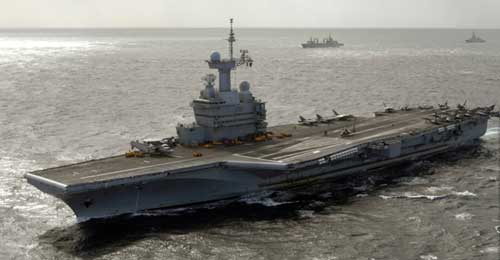 |
|
USS Ronald Reagan (CVN-76) |
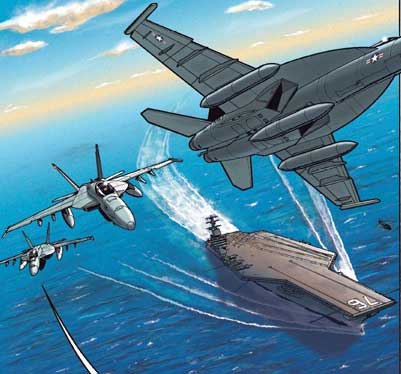 |
The US Navy nuclear powerd supercarrier USS Ronald Reagan is shown in the story COBRA NOIR. |
In this adventure the USS Reagan has been temporarly modified with a Sky Jump device in order to allow the utilization of the russian naval fighters SU-33. |
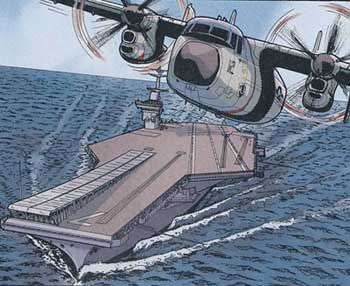 |
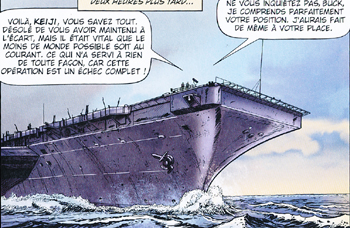 |
The US Navy nuclear powerd supercarrier USS Ronald Reagan is also shown in the stories LA NUIT DU SPECTRE, DEFCON ONE, VOSTOK NE REPOND PLUS and LE PACTE!. |
Formosa shows again the USS Ronald Reagan in the adventure VOSTOK NE REPOND PLUS. |
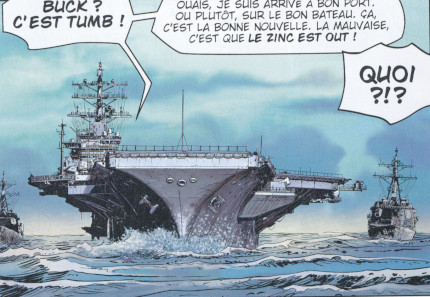 |
 |
The US Navy nuclear powerd supercarrier USS Ronald Reagan is also shown in 2025 by Philippe in the stories TRAQUE EN HAUTE ALTITUDE and ORBITE MORTELLE. |
USS Ronald Reagan (CVN-76) is a Nimitz-class nuclear-powered supercarrier in the service of the United States Navy. The ninth ship of her class, she is named in honor of former President Ronald Reagan, President of the United States from 1981 to 1989. Upon her christening in 2001, she was the first ship to be named for a still living former president.
As of May 2012 the ship is operationally part of Carrier Strike Group Nine and administratively under the command of Commander, Naval Air Forces Pacific/Commander, Naval Air Forces. The two administrative titles actually refer to one command carrying out two functions. In January 2014, the U.S. Navy announced that the Ronald Reagan will replace the USS George Washington (CVN-73) as the flagship of Carrier Strike Group Five, the only forward-based carrier strike group home-ported at Yokosuka, Japan, as part of the U.S. Seventh Fleet.
|
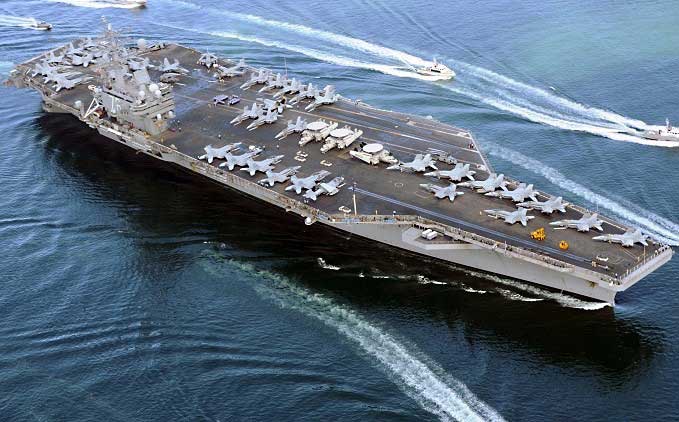 |
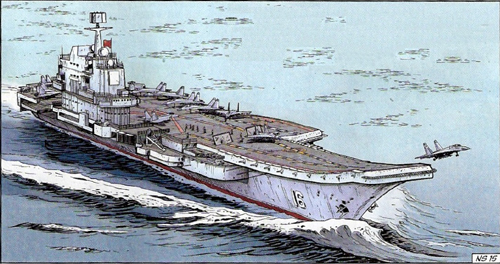 |
The Chinese Navy aircraft carrier Liaoning 16 is well represented in the stories LA NUIT DU SPECTRE and DEFCON ONE. |
Liaoning (16), is the first aircraft carrier commissioned into the People's Liberation Army Navy Surface Force. It is classified as a training ship, intended to allow the Navy to practice with carrier usage.
Originally laid down as the Admiral Kuznetsov class multirole aircraft carrier Riga for the Soviet Navy, she was launched on December 4, 1988, and renamed Varyag in 1990. The stripped hulk was purchased in 1998 by the People's Republic of China and towed to Dalian Shipyard in northeast China. After being completely rebuilt and undergoing sea trials, the ship was commissioned into the PLAN as Liaoning on September 25, 2012.
In August 2014, the Chinese-language Shanghai Morning Post listed that the Liaoning would carry 36 aircraft: 24 Shenyang J-15 fighters; 6 Changhe Z-18F anti-submarine warfare (ASW) helicopters; 4 Changhe Z-18J airborne early warning helicopters; and 2 Harbin Z-9C rescue helicopters. The Chinese carrier aircraft inventory is similar to a balanced combat and support aircraft approach intended for Soviet aircraft carriers, which supported nuclear submarines, large surface combatants, and land-based strike bombers performing anti-access roles. The air wing lacks long-range radar and anti-submarine fixed-wing aircraft, needing support from shore-based aircraft such as Tupolev Tu-154 ASW and Shaanxi Y-8 AWACS aircraft. The US Department of Defense noted that J-15s will have below normal range and armament when operating from the carrier, due to limits imposed by the ski-jump takeoff system. The lack of a carrier onboard delivery aircraft like the United States Navy (USN) Grumman C-2 Greyhound also limits logistics capabilities. The Liaoning would need extensive land-based support to oppose a USN carrier battle group; however, it would be potent against the Vietnam People's Navy and the Philippine Navy. Deficiencies will likely be corrected with future aircraft carriers, which are expected to be larger with conventional takeoff decks and catapult launching for heavier fighters, plus fixed-wing radar and anti-submarine patrol aircraft.
|
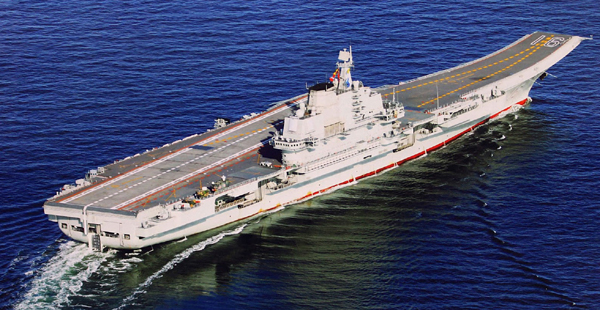 |
|
|